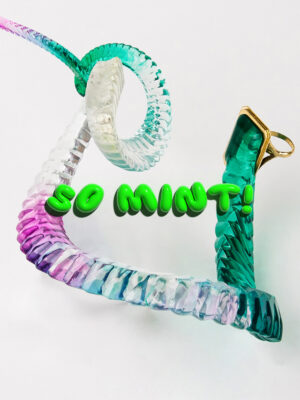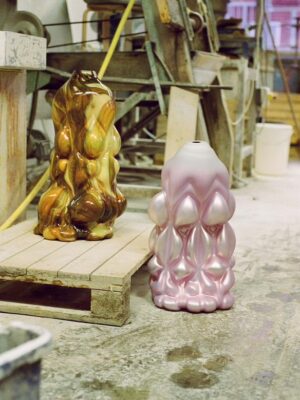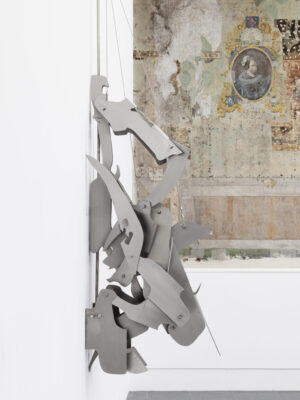Daye Kim is a London-based craft artist and jewellery designer whose practice explores the invisible connections that bind us to each other and our environment. Working primarily in metal, she creates pieces that make tangible the intangible relationships we often take for granted. Her approach combines traditional Korean metalwork with digital fabrication, always prioritising the sensory experience of the wearer. Each piece functions as both ornament and meditation, using weight, texture, and movement to heighten awareness of our interconnectedness. Through this sensory and material language, her work transforms jewellery into a vehicle for contemplation, encouraging wearers to notice the subtle, profound ties that shape our daily lives

‘Can an authentic connection emerge when we’re performing cultural expectations’ While Korean traditional values emphasise sibling unity and familial obligation, the emotional reality is far more complex. Daye Kim’s work explores the paradox of sibling bonds—how those we trust most can also provoke jealousy, competition, and resentment, challenging cultural ideas of harmony and support.
Current Obsession:
Daye Kim: This Relationship Is… explores the paradox of sibling bonds: how the people we trust most can also trigger our deepest insecurities. Growing up with my sister, I noticed we shared something profound yet contradictory. We were each other’s closest allies, yet beneath that trust lay unexpected rivalry. I’d watch her succeed and simultaneously feel pride and envy. Why did loving her most also mean competing with her? This complexity fascinated me because sibling relationships shape how we connect with othersthroughout life. They’re our first experience of intimacy mixed with difference, love tangled with comparison.
My collection draws from the famous Portrait of Gabrielle d’Estrées and Her Sister, using the simple ring from that painting as my starting point. Through 3D programming, I created randomly generated, distorted structures that visualise these emotional contradictions. Each twisted form represents how our feelings towards siblings shift and change. Some pieces are designed for multiple wearers, letting people physically experience these relational dynamics. The varied colours and structures reflect how every sibling relationship is unique, yet universally complex. I wanted to explore this now because understanding these foundational relationships helps us make sense of all our connections—romantic, platonic, and professional. Siblings teach us that love isn’t simple.


‘Unexpectedly, digital software became my emotional vocabulary. I resisted 3D programmes at first, believing they would distance me from the tactile intimacy of traditional metalwork—but the random generation functions weren’t just design variations; they were emotional possibilities I hadn’t recognised.’
CO:
DK: Unexpectedly, digital software became my emotional vocabulary. I initially resisted 3D programmes, believing they would distance me from the tactile intimacy of traditional metalwork. But when struggling to express the twisted complexity of sibling relationships, ZBrush and Blender became unexpected collaborators rather than mere tools. ZBrush taught me something profound: distortion could be precise. While my hands understood how to bend metal, the software showed me how to bend emotion into form. The random generation functions created structures I’d never conceived manually—some grotesque, others surprisingly tender. These weren’t just design variations; they were emotional possibilities I hadn’t recognised.
Blender’s rendering capabilities let me preview colours and textures virtually, but more importantly, it helped me understand how light interacts with twisted surfaces. This taught me that the shadows cast by distorted forms were as meaningful as the forms themselves, representing the hidden aspects of relationships. The software’s unpredictability became crucial. Traditional craft relies on controlled repetition, but algorithms introduced chance. This randomness mirrors how relationships evolve, we think we understand someone completely, then they surprise us. Digital tools didn’t replace my hands; they extended my emotional range, helping me articulate feelings that traditional techniques alone couldn’t capture.
DK: My work responds to the tension between individual authentic emotions and Korean social expectations around family harmony. In Korean culture, maintaining family cheomyeon (체면, social face) often requires suppressing personal feelings that might disrupt group harmony. Siblings are expected to be naturally supportive and unified, yet privately we experience complex emotions such as jealousy, competition, and resentment that contradict these social ideals.
This cultural dissonance became central to my practice. Korean society values collective harmony over individual emotional expression, creating internal conflict when personal feelings don’t align with social expectations. My sister and I experienced this tension firsthand, feeling competitive while being expected to demonstrate unwavering mutual support. This Relationship Is.. explores these contradictory cultural pressures. The distorted forms represent how social expectations can warp authentic emotional responses. While Korean traditional values emphasise sibling unity and familial obligation, the reality is far more psychologically complex.
My work questions whether cultural ideals of perfect family relationships actually prevent us from developing genuine intimacy. The pieces designed for communal wearing explore this paradox. Can an authentic connection emerge when we’re performing cultural expectations? Through jewellery, I’m examining how many people navigate between private emotional truth and public cultural conformity, particularly within tight-knit family structures where individual expression might threaten collective stability.

Instagram @_dd___k
All images courtesy of the artist.
Our annual series SO MINT! is back, shining a spotlight on the rising talents of fresh graduates in fashion, jewellery, and design from around the world.
Are you a recent graduate with remarkable work to share? Submit your portfolio via this link!
Submissions are open until the end of August 2025.
If you have any questions, please don’t hesitate to contact us via veronika@current-obsession.com.








